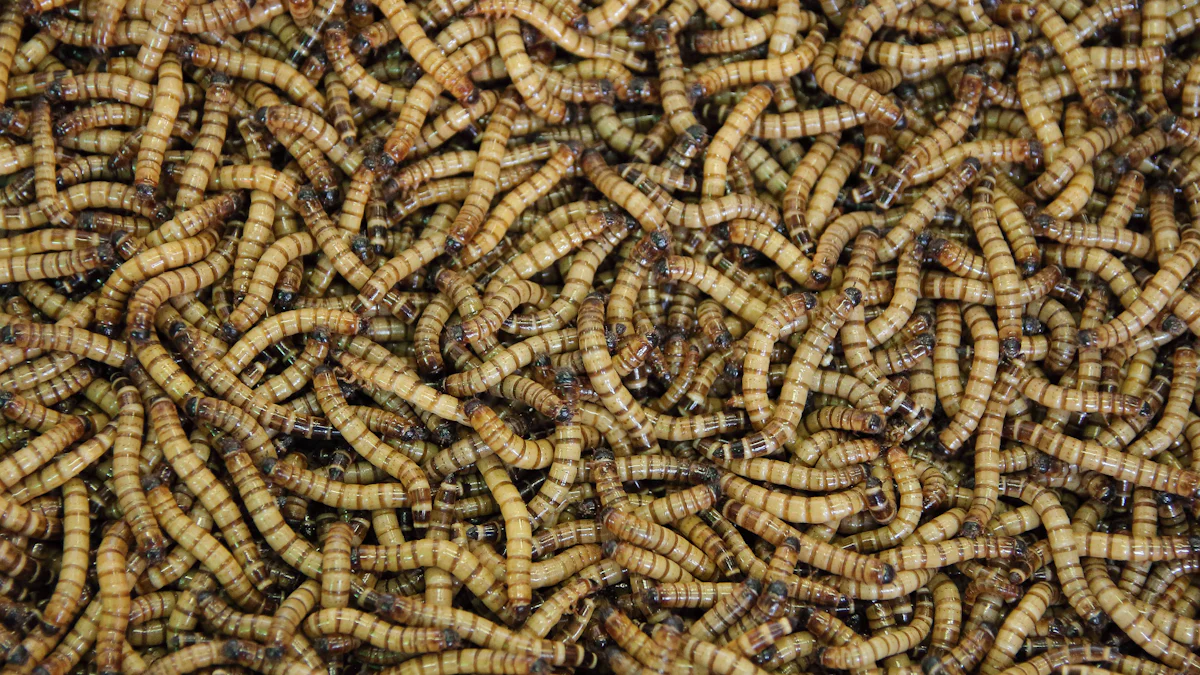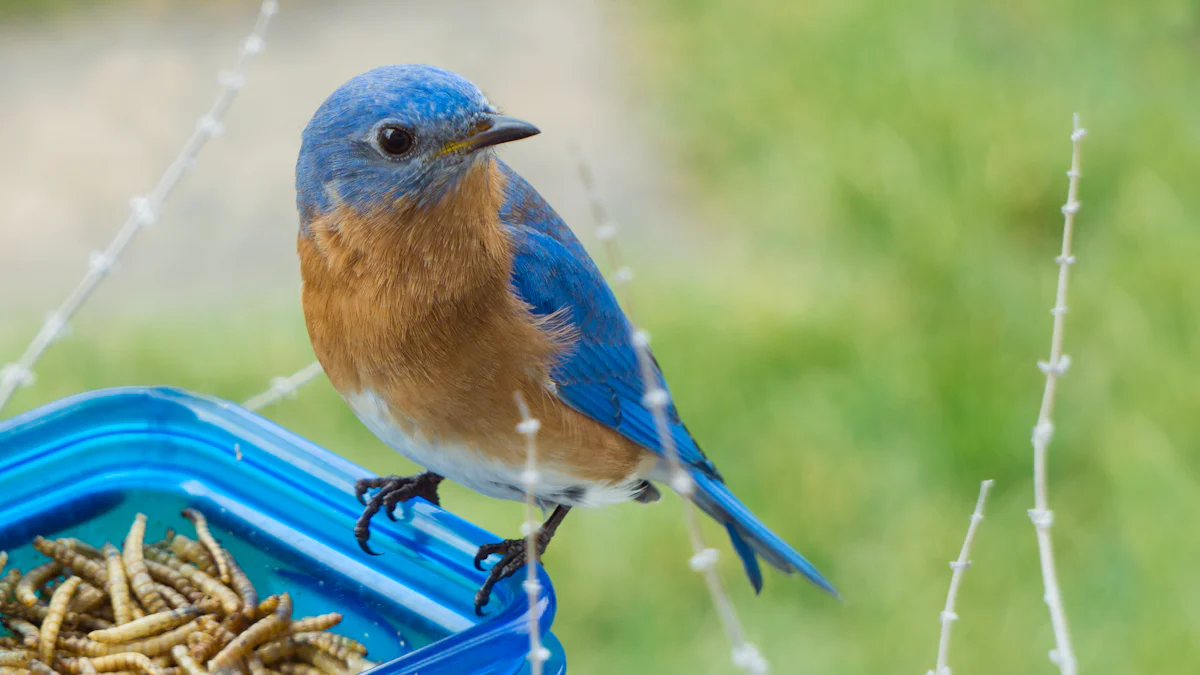
Have you ever wondered how to make dried mealworms even better for your backyard birds? Rehydrating them is the answer! It’s super easy and gives birds a treat that’s closer to what they’d find in nature. When you soak dried mealworms, they regain moisture, making them juicier and more nutritious.
Take a look at how rehydrated mealworms compare to dried ones:
| Nutrient | Dried Mealworms | Live Mealworms |
|---|---|---|
| Moisture Content | 5% | 62% |
| Protein Value | 53% | 20% |
| Fat Value | 28% | 13% |
| Fiber Value | 6% | 2% |
Rehydrated mealworms offer a balance between the convenience of dried ones and the natural appeal of live insects. Birds love the softer texture, and you can even use them as a Bird Dried Mealworm Topping to mix with other foods. It’s a simple way to keep your feathered friends happy and healthy!
Key Takeaways
- Soaking dried mealworms makes them softer and easier for birds to eat. It also gives birds extra water, which is helpful in hot or dry weather.
- Put mealworms in warm water for 20-30 minutes. This makes them softer, tastier, and healthier for birds.
- Give rehydrated mealworms in the morning or late afternoon. These times are when birds eat the most, so more birds will visit.
Why Rehydrate Dried Mealworms?
Improved hydration for birds
When you rehydrate dried mealworms, you’re giving birds a much-needed boost of moisture. I’ve noticed that soaking mealworms makes them softer and easier for birds to eat. This is especially helpful during hot summers or dry winters when natural water sources might be scarce.
Here’s why it works:
- Soaking restores the mealworms’ natural texture, making them juicier.
- Birds get a bit of extra hydration with every bite, which helps reduce dehydration risks.
- The soaking process also enhances the flavor and scent, making the mealworms irresistible to your feathered visitors.
I’ve seen birds flock to rehydrated mealworms faster than the dried ones. It’s like offering them a gourmet treat instead of a plain snack!
Enhanced texture and palatability
Let’s face it—dried mealworms can be a little tough and crunchy. Rehydrating them changes everything. The texture becomes softer, almost like live insects, which birds naturally prefer. I’ve found that even picky eaters, like robins and bluebirds, are more likely to enjoy rehydrated mealworms.
The softer texture also makes them easier to digest. This is especially important for young birds or smaller species that might struggle with harder foods. If you want to make your feeding station the go-to spot, rehydrated mealworms are the way to go. You can even sprinkle them as a Bird Dried Mealworm Topping on other bird foods for an extra treat!
Increased nutritional value
Rehydrating mealworms doesn’t just improve their texture—it also boosts their nutritional value. When you soak them, they absorb water, which helps birds stay hydrated. Plus, the soaking process can make the nutrients in the mealworms easier for birds to digest and absorb.
I’ve noticed that birds seem more energetic and active after eating rehydrated mealworms. It’s like giving them a little energy boost to help them thrive. Whether you’re feeding backyard birds or preparing for migration season, rehydrated mealworms are a simple way to support their health.
How to Rehydrate Dried Mealworms

Step 1: Gather your materials
Before you start, make sure you have everything ready. Here’s what you’ll need:
- Dried mealworms
- A clean bowl
- Warm water
- Optional: You can mix the water with a bit of broth or juice to add extra flavor.
I like to keep things simple, but adding a little flavor can make the mealworms even more appealing to birds. Just make sure the bowl is clean and the water is free from any contaminants.
Step 2: Soak mealworms in water
Once you’ve got your materials, it’s time to soak the mealworms. Place them in the bowl and pour enough warm water to fully submerge them. If they float, press them down gently with a spoon. Warm water works best because it softens the mealworms faster.
Sometimes, I stir the mealworms a bit while they soak. This helps them absorb water evenly and ensures they’re nice and plump for the birds.
Step 3: Adjust soaking time based on preference
The soaking time depends on how soft you want the mealworms to be. I usually let them soak for about 20-30 minutes. This gives them a texture that’s close to live insects, which birds love. If you’re in a hurry, 15 minutes can work too, but longer soaking makes them juicier.
For an extra boost, you can add a few drops of vitamin supplements to the water. It’s a great way to make the mealworms even more nutritious.
Step 4: Drain and prepare for feeding
After soaking, drain the mealworms using a fine mesh strainer or colander. Make sure to get rid of all the excess water. I like to give them a quick shake in the strainer to ensure they’re not too wet.
Now they’re ready to serve! You can place them in a feeder or sprinkle them as a Bird Dried Mealworm Topping on other bird foods. Birds will flock to your feeding station in no time.
Tips for Feeding Rehydrated Mealworms to Birds
Best times to offer mealworms
Timing matters when feeding birds. I’ve found that early morning and late afternoon are the best times to offer rehydrated mealworms. Birds are most active during these hours, searching for food to fuel their day or prepare for the night. Offering mealworms during these peak times ensures they’ll get noticed quickly.
During nesting season, I like to provide mealworms more frequently. Parent birds need extra energy to feed their chicks, and rehydrated mealworms are perfect for this. In colder months, mealworms can also be a lifesaver. Birds burn more calories to stay warm, so a high-protein snack like this helps them stay strong.
How to present mealworms at feeding stations
Presentation makes a big difference. I usually place rehydrated mealworms in a shallow dish or tray feeder. This keeps them visible and easy for birds to access. If you have a platform feeder, that works great too. Just make sure it’s clean and dry before adding the mealworms.
For ground-feeding birds like robins, I scatter a few mealworms on the ground. It mimics their natural foraging behavior. If you’re worried about pests, try using a hanging feeder designed for mealworms. It keeps the food safe while still attracting birds.
Combining mealworms with other bird foods (Bird Dried Mealworm Topping)
Rehydrated mealworms pair well with other bird foods. I often mix them with seeds, suet, or fruit to create a balanced meal. Sprinkling them as a Bird Dried Mealworm Topping on a seed mix is one of my favorite tricks. It adds variety and makes the mealworms even more appealing.
You can also use mealworms to attract specific birds. Bluebirds and wrens love them, especially when combined with soft fruits. Experiment with different combinations to see what works best in your yard. Birds enjoy the variety, and it keeps them coming back for more.
Storing Rehydrated Mealworms
Short-term storage tips
Once you’ve rehydrated mealworms, it’s important to store them properly to keep them fresh. I usually refrigerate them if I plan to use them within a few days. Here’s what works best:
- Place the mealworms in a clean, airtight container.
- Store them in the fridge at a temperature between 45-50°F.
- Use them within 3-5 days to ensure they stay fresh and safe for birds.
Keeping them cool slows down spoilage and keeps them ready for your feathered visitors. If you’re not planning to use them right away, don’t leave them out at room temperature for too long. Warm conditions can cause them to spoil quickly.
How to avoid spoilage
Spoiled mealworms aren’t just unappetizing—they can also harm birds. I always check for signs of spoilage before feeding them. Here’s what to look for:
- A bad or off smell.
- Discoloration, like dark spots or unusual colors.
- Mold growth on the mealworms.
If you notice any of these, it’s best to toss them out. To prevent spoilage, I recommend storing them in a cool, dark place if refrigeration isn’t an option. Use a tight-sealing container to keep moisture and pests out.
Can you freeze rehydrated mealworms?
Yes, freezing is a great option for long-term storage! I’ve found that freezing rehydrated mealworms keeps them fresh for months. Here’s how I do it:
- Place the mealworms in a clean, freezer-safe bag or container.
- Seal it tightly to prevent freezer burn.
- Store them in the freezer, where they’ll stay good for up to a year.
Freezing also helps preserve their texture and nutrients. When I’m ready to use them, I just thaw the amount I need and serve them to the birds. It’s an easy way to make sure I always have a supply on hand, even during busy weeks.
Post time: Feb-06-2025
